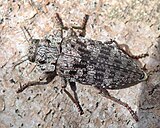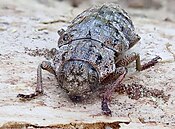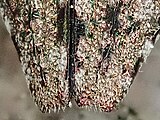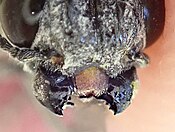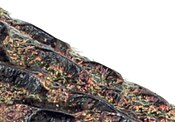Dicerca autumnii
| Dicerca autumnii | ||||||||||||
|---|---|---|---|---|---|---|---|---|---|---|---|---|

Dicerca herbstii on a dying Greek fir |
||||||||||||
| Systematics | ||||||||||||
|
||||||||||||
| Scientific name | ||||||||||||
| Dicerca autumnii | ||||||||||||
| Gravel weather , 1857 |
Dicerca herbstii (often incorrectly Dicerca herbsti written) is a beetle from the family of the jewel beetle . The genus Dicerca is represented in Europe with seven species , the species Dicerca herbstii belongs to the subgenus Argante .
The beetle is very rare and only occurs in eastern southern Europe.
Note on names and synonyms
Since the two species Dicerca moesta and Dicerca herbstii are both rare and very similar, they were initially listed as just one species and were often confused with one another in the collections. This is also reflected in the synonyms . In 1801 Herbst describes the more common Dicerca moesta under the name Buprestis quadrilineata . Herbst also mentions different properties of a single specimen that he received from Megerle . In 1825, Charpentier placed the two species Buprestis quadrilineata and Buprestis moesta in his Horae entomologicae one after the other and then only explains the differences between the two species, but in great detail. This shows that Charpentier describes the species Dicerca herbstii under Buprestis quadrilineata , so Buprestis quadrilineata Charpentier is a synonym for Buprestis herbstii . Buprestis quadrilineata Herbst, on the other hand, is a synonym for Dicerca moesta .
The species name quadrilineata ( lat. Quadri- for 'four' and lineata for 'striped') refers to four dark longitudinal lines on the pronotum. These are developed in both types.
The beetle was first described by Kiesenwetter in 1857 . Kiesenwetter recognizes that the specimen sent by Megerle to Herbst and valued by Herbst as a special form of his Buprestis quadrilineata represents its own species. Kiesenwetter names it in honor of Herbst Buprestis (Dicerca) herbstii and already places it in the subgenus Argante . Even before describing the beetle, Kiesenwetter included the species under the name Dicerca herbstii in the Catalogus Coleopterorum Europae (Catalog of European Beetles). The beetle is listed there as a species from the 4th edition.
The scientific name of the genus Dicerca is from Altgr. δι dí for 'two' and κέρκος kérkos for 'tail' derived and refers to the fact that the tail-like elongated ends of the wing covers more or less gape apart.
The name of the subgenus Argánte is from Old Gr . αργής argés for 'white', derived 'shiny'. Gistel thus separated the lighter from the darker species of the genus Dicerca .
Properties of the beetle
The twelve to seventeen millimeter long beetle is elongated oval, somewhat more elongated and somewhat more arched than Dicerca moesta . The underside is shiny red-copper, the top matt and dark copper with only a little ore shimmer. Non-raised areas on the upper side are often dusted whitish.
The head is coarsely wrinkled punctured , irregularly pressed her forehead. The eleven-segment antennae are barely as long as the pronotum and bluntly cut inwards. The upper lip is cut out (Fig. 6). The upper jaw is strongly curved and three-toothed (Fig. 6). The jaw probes are four-part, the two end parts spherical-egg-shaped. The end link of the lip switch is egg-shaped.
The pronotum is almost straight at the front with protruding corners at an acute angle, the base is very flat on both sides, the rear corners are rectangular. The pronotum is wider in the front half than behind and it is almost angularly bulged in front of the middle, more noticeable than in Dicerca moesta . In the middle run four slightly raised, wrinkled, dark longitudinal keels. While these in Dicerca moesta are clearly aligned approximately parallel to each other in a straight line, in Dicerca herbstii they are only weakly and indistinctly developed and not very regular. The two outer longitudinal keels are usually broadly interrupted in the rear half, the inner longitudinal keels are bent crookedly apart in the middle and enclose a smooth, raised surface a little in front of the middle.
The label is wider than it is long, fairly smooth, sometimes indented lengthways in the middle.
The elytra are wider than the pronotum. They are little or not at all broadened behind the middle. Towards the top of the wing they are narrowed almost in a straight line. The tip of the wing covers (Fig. 5) is slightly elongated, the end slightly truncated so that the outer corner lies slightly behind the inner corner. The corner at the seam is clearer, the outer corner less clearly drawn out into a tooth. The elytra are striped, the even intervals roughly and densely dotted, the somewhat wider odd intervals (starting at the seam) are divided into raised, largely smooth sections (mirror spots) and non-raised, densely dotted sections (Fig. 10). In contrast to Dicerca moesta , the mirror spots are very coarse, irregularly delimited and sometimes run into one another. The lateral edge of the elytra is not completely margined towards the tip, but is irregularly weakly notched (Fig. 8).
The thighs of the males are thickened, stronger than in Dicerca moesta . The thighs of the middle pair of legs are long and thinly hairy on the inside of the males (Fig. 7). The middle rails of the males are widened to a clear corner in the first third (Fig. 9). The five-limbed tarsi are short and wide, the three middle limbs are flap-shaped below, the claw limb arises near the base of the fourth limb, which is deeply incised on top.
The underside (Fig. 4) is dense and deeply dotted. The points are rounded in front and flowing into one another, they form short longitudinal wrinkles towards the rear. The process of the fore-chest reaching into the mid-chest (Prosternal process) is broad between the front hips, deepened at most in a very shallow groove-shaped manner and punctured to the edge. The sides of the prosternal process are only very slightly raised, they are not bounded by a smooth, raised keel. The rear breast shows a sloping longitudinal rib on both sides that extends to the thigh covers of the hind legs (only very indistinctly visible in Fig. 4). The last segment of the abdomen is flat in the male, clearly delineated, in the female it is rounded to a point.
biology
The adult animals can be found on dying specimens of the Greek fir . The larvae also develop in these. The species is counted among the beetles that mainly develop in standing, sunny, medium-thick deadwood structures, in which the mycelia in the wood develop only very slowly due to the dryness caused by the sun.
The period of finds of adult beetles in Greece is between April 17th and September 18th. Between September 8th and 28th, a total of four specimens of the beetle hatched from logs that were brought back to Germany from Greece. It is believed that the late time of hatching is due to the colder climate in Germany. The development takes several years. In the few cases observed, the doll's cradle was placed 1.6 to 2 cm below the surface. The slipways were almost perpendicular to the surface. The loopholes were approximately elliptical, the major axis on average 1.8 times as large as the minor axis (3 measurements). The beetles hatched at night.
distribution
Kiesenwetter mentions in 1857 that the beetle has so far only been found, and extremely rarely, in the Austrian Alps . The few older information about finds in Austria / South Tyrol have been questioned several times and are probably based on incorrect determinations or confusion of the location. In 1981 it was proposed to delete the beetle from the Central European fauna. According to today's information, the beetle's distribution area is limited to Albania , Greece and North Macedonia .
literature
- Heinz Joy, Karl Wilhelm Harde, Gustav Adolf Lohse: The beetles of Central Europe . tape 6 : Diversicornia . Spectrum, Heidelberg 1979, ISBN 3-87263-027-X , p. 213 .
- Gustav Jäger (Ed.): CG Calwer’s Käferbuch. 3. Edition. K. Thienemanns, Stuttgart 1876, p. 329.
Individual evidence
- ↑ a b c Dicerca herbstii as Dicerca herbsti in Fauna Europaea, accessed on September 11, 2019
- ^ Johann Friedrich Wilhelm Herbst: Natural system of all known domestic and foreign insects, ... the beetle ninth part Berlin 1801 Comment on the specimen by Megerle p. 105
- ^ A b Toussaint de Charpontier: Horae entomologicae Wratislava (Breslau) 1825 p. 187 as Buprestis quadrilineata
- ↑ Dicerca moesta with synonym Dicerca quadrilineta Herbst 1801 at FE, accessed on September 14, 2019
- ↑ a b c d H. v. Kiesenwetter: Natural history of the insects of Germany 1. Section IV. Volume, Berlin 1857 P. 40 ff B. Herbstii
- ↑ Catalogus Coleopterorum Europae Entomological Association Stettin, 6th edition, Stettin 1856 p. 44 Dicerca herbstii in the Google book search
- ^ A b Sigmund Schenkling: Nomenclator coleopterologicus 2nd edition, Jena 1922
- ↑ H.Mühle, P. Brandl, M. Niehuis: Catalogus Faunae Graeciae; Coleoptera: Buprestidae Printed in Germany by Georg Rößle Augsburg 2000
- ↑ Georg Möller: Structure and substrate binding of wood-dwelling insects, focus on Coleoptera - Beetle Dissertation submitted in the Department of Biology, Chemistry, Pharmacy at the Free University of Berlin March 2009 p. 65/56 and p. 140 / table 8
- ↑ Manfred Niehuis: Comments on the distribution and biology of Dicerca herbsti and some other jewel beetles (Coleoptera: Buprestidae) Ent.Zeitschrift, 90: 114-120. 1980
- ↑ Klaus Hellrigl: Faunistics of the jewel beetles South Tyrol's Forest observer vol. 5, 2010 p. 161
- ↑ Hans Mühle: Relict species (Coleoptera - Buprestidae) in Entomofauna - Journal for Entomology Volume 2 Issue 25, ISSN 0250-4413 Linz, October 25, 1981 as PDF
